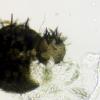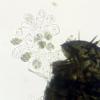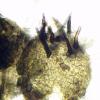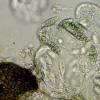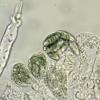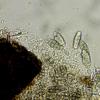
09-11-2025 13:20
Hello.A tiny ascomycete, appearing as erupting gra

08-11-2025 00:29
 Francois Guay
Francois Guay
I found this species in Quebec, Canada, on herbace

04-11-2025 09:07
Hello.A suspected Hymenoscyphus sprouting on a thi

04-11-2025 12:43
 Edvin Johannesen
Edvin Johannesen
Hi! One more found on old Populus tremula log in O

03-11-2025 21:34
 Edvin Johannesen
Edvin Johannesen
These tiny (0.4-0.5 mm diam.), whitish, short-stip

Hi All,
I found these setose perithecia while looking at Rihizodiscina lignyota on decorticated Salix cinerea. They are minute (0.05-0.1mm) with apical setae up to about 40 long. The muriform ascospores are 17.5-19x7-8. In Ellis and Ellis there are a number similar Venturia species but with completey different ascospores. I would be grateful for any ideas.
Best wishes,
Charles.
Quelle coïncidence!
Our local mycology group is partway through a local Spring Fungi Fortnight and have a identical-looking collection, but on the hymenium of a resupinte basidiomycete (on Ulex):
Partly because of the fungicolous lifestyle we provisionally called it Capronia acutiseta, what do you think?
https://www.sussexfungusgroup.co.uk/capronia-sp
Cheers,
Nick

Hi Nick,
Many thanks for the rapid response. It certainly does seem a very good match. Have to say that your micro photos are excellent. Could not find it in either of the Ellis volumes-how did you arrive at this ID? The perithecia (or pseudothecia) seemed just to be seated on the dead wood but may be associated within fungal hyphae within the wood Looking in my files I notice that I had this fungus five years ago in a different location on Anglesey but was not au fait with AscoFrance then! Recently I posted a Nectria type on this forum but that one drew a blank.
Could we have met on any BMS forays?
Best wishes,
Charles.
I don't think we've met yet, though hopefully our paths will cross one day!
I ran it through Gernot Friebes' excellent key:
https://www.researchgate.net/publication/292919067_A_key_to_the_non-lichenicolous_species_of_the_genus_Capronia_Herpotrichiellaceae
I also used this key to some recently descibed Argentinian species, authored by Andy Miller et al:
https://www.researchgate.net/publication/334570277_New_species_of_Capronia_Herpotrichiellaceae_Ascomycota_from_Patagonian_forests_Argentina
I referred to the original description (available at cyberliber), which I note has several discrepancies, for example the text description of the spores doesn't match well with the illustration with regards to size and septation.
Unfortunately our collection isn't suitable for DNA extraction - How plentiful is yours?
Cheers,
Nick

